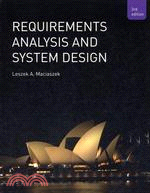| FindBook |
有 1 項符合
REQUIREMENTS ANALYSIS AND SYSTEM DESIGN 3/E的圖書 |
 |
REQUIREMENTS ANALYSIS AND SYSTEM DESIGN 3/E 作者:LESZEK A. MACIASZEK 出版社:全華圖書股份有限公司(全華經銷) 出版日期:2007-01-01 規格:23.5*19cm / 612頁 |
| 圖書館借閱 |
| 國家圖書館 | 全國圖書書目資訊網 | 國立公共資訊圖書館 | 電子書服務平台 | MetaCat 跨館整合查詢 |
| 臺北市立圖書館 | 新北市立圖書館 | 基隆市公共圖書館 | 桃園市立圖書館 | 新竹縣公共圖書館 |
| 苗栗縣立圖書館 | 臺中市立圖書館 | 彰化縣公共圖書館 | 南投縣文化局 | 雲林縣公共圖書館 |
| 嘉義縣圖書館 | 臺南市立圖書館 | 高雄市立圖書館 | 屏東縣公共圖書館 | 宜蘭縣公共圖書館 |
| 花蓮縣文化局 | 臺東縣文化處 |
|
|
- 圖書簡介
An examination of the methods and techniques used in the analysis and design phases of Information System development. Emphasis is placed upon the application of object technology in enterprise information systems (EIS) with UML being used throughout. Through its excellent balance of practical explanation and theoretical insight the book manages to avoid unnecessary, complicating details without sacrificing rigor. Examples of real-world scenarios are used throughout, giving the reader an understanding of what really goes on within the field of Software Engineering.
- 目次
Preface
Guided Tour
Publisher's acknowledgements1 The Software Process
Objectives
1.1 The nature of software development
1.2 System planning
1.3 Systems for htree management levels
1.4 Th software development lifecycle
1.5 Development models and methods
1.6 Problem statements for case studies
Summary
Key terms
Multiple choice tests
Questions
Review quiz answers
Multiple choice answers
Answers to odd-numbered questions2 Requirements determination
Objectives
2.1 From business processes to solution envisioning
2.2 Requirements elicitation
2.3 Requirements negotiation and validation
2.4 Requirements management
2.5 Requirements business model
2.6 Requirements document
Summary
Key terms
Multiple choice tests
questions
Exercises (advertising expenditure)
Exercises (time logging)
Review quiz answers
Multiple choice answers
Answers to odd-numbered questions
Solutions to exercises (AE)3 Fundamentals of Visual Modeling
Objectives
3.1 Use case view
3.2 Activity view
3.3 Structure view
3.4 Interaction view
3.5 State machine view
3.6 IMplementation view
Summary
Key terms
Multiple choice tests
Questions
Exercises
Exercises (video store)
Review quiz answers
Multiple choice tests
Answers to odd-numbered questions
Solutions to odd-numbered exercises
Solutions to odd-numbered exercises (video store)4 Requirements specification
Objectives
4.1 Architectural prerogatives
4.2 State specifications
4.3 Behavior specifications
4.4 State change specifications
Summary
Key terms
Multiple choice tests
Questions
Exercises (video store)
Exercises (contact management)
Exercises (univeristy enrolment)
Review quiz answers
Multiple choice answers
Answers to odd-numbered questions
Solutions to exercises (university enrolment)5 Moving from Analysis to Design
Objectives
5.1 Advanced class modeling
5.2 Advanced generalizations and inhertance modeling
5.3 Advanced aggregation and delegation modeling
5.4 Advanced interaction modeling
Summary
Key terms
Multiple choice tests
Questions
Exercises
Exercises (time logging)
Exercises (advertising expenditure)
Review quiz answers
Multiple choice answers
Answers to odd-numbered questions
Solutions to odd-numbered exercises
Solutions ot exercises (time logging)6 System Architecture and Program Design
Objectives
6.1 Distributed physical architecture
6.2 Multi-layer logical architecture
6.3 Architectural modeling
6.4 Principles of program design and reuse
6.5 Collaboration modeling
Summary
Key terms
Multiple choice tests
Questions
Exercises (video store)
Exercises (advertising expenditure)
Review quiz answers
Multiple choice answers
Answers to odd-numbered questions
Solutions to exercises (advertising expenditure)7 Graphical User Interface Design
Objectives
7.1 Principles of GUI use
7.2 Desktop GUI design
7.3 Web GUI design
7.4 Modeling GUI navigation
Summary
Key terms
Multiple choice tests
Questions
Exercises (contact management)
Exercises (telemarketing)
Review quiz answers
Multiple choice answers
Answers to odd-numbered questions
Solutions to exercises (contract management)8 Persistence and Database Design
Objectives
8.1 Business objects and persistence
8.2 Relational database model
8.3 Object-relational mapping
8.4 Patterns for managing persistent objects
8.5 Designing database access and transactions
Summary
Key terms
Multiple choice tests
Questions
Exercises (contact management)
Exercises (telemarketing)
Review quiz answers
Multiple choice answers
Answers to odd-numbered questions
Solutions to exercises (CM)9 Quality and Change Management
Objectives
9.1 Quality management
9.2 Change management
Summary
Key terms
Multiple choice tests
Questions
Review quiz answers
Multiple choice answers
Answers to odd-numbered questions10 Tutorial-style Review and Reinforcement
10.1 Use case modeling
10.2 Activity modeling
10.3 Class modeling
10.4 Interaction modeling
10.5 State machine modeling
10.6 Implementation models
10.7 Object collaboration design
10.8 Wimdow navigation design
10.9 Database design
Summary
Exercises (online shopping)Appendix Fundamentals of Object Technology
A.1 Real-life analogy
A.2 Instance object
A.3 Class
A.4 Variables, methods, and constructors
A.5 Association
A.6 Aggregation and composition
A.7 Generalization and inheritance
A.8 Abstract class
A.9 Interface
Summary
Questions
Answers to odd-numbered questions
Index
|











